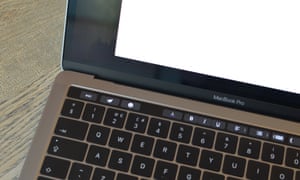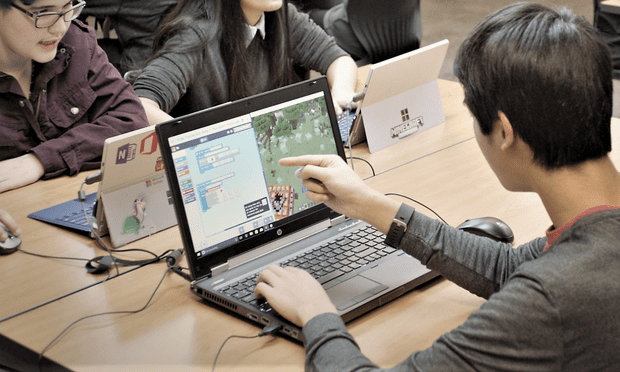Robert is looking for a laptop that has a keyboard like an old MacBook Air
My son has grown up using a MacBook Air for Minecraft. He swears by the keyboard layout, and having witnessed the blazing speed with which he does things in the game, I understand his reluctance to use his Alienware laptop. (I know, first-world problems, and all that …)
Both machines are almost six years old and due a refresh, so I’m looking for a Windows laptop that is powerful enough to run games like Civilization 6 (with mods) but with a keyboard layout that is sufficiently similar to a MacBook that he can continue to use the muscle memory he has built up over the years. Does such a beast exist?
One alternative is to buy a MacBook Pro and use it to run Windows (either Bootcamp or Parallels), but the Windows performance strikes me as a compromise (for more money).
Budget is a maximum of £1,500. Would be more than happy with cheaper as long as performance wasn’t compromised too much. Robert
Take your son to an Apple store or a good computer shop where he can try a MacBook Pro, ideally running Minecraft. In this case, my normal advice – stick with what you know – runs into the problem that what you know no longer exists, unless you buy a second-hand laptop.Advertisement
All Apple’s MacBook Pros now have touch bars instead of function keys, and I agree with Mac fan John Gruber that they have terrible keyboards. Obviously, personal taste is a major factor in keyboard preferences, and I’m sure some people like the “butterfly” keys that have had well-publicised problems. Either way, they are very different from old MacBook Air keyboards.
Apple notes that “for some apps, you can make the function keys display permanently in touch bars” by changing the settings in system preferences, so this is something your son should try. However, I expect the new-style keys and touch bars will not map exactly to his “motor memory” so some relearning will be required. (I’ll go into a possible solution later.)
If so, he might be prepared to switch to a Windows 10 laptop for Minecraft. Windows is the main platform for serious gaming, and many games – including Minecraft – run better on Windows. Also, he’s young enough to learn to use a Windows keyboard with similar alacrity, which should stand him in good stead for decades to come. Older users can resist change because the relearning period is longer and the payback time is shorter, but that’s a bad strategy for a child.
Keyboard mapping

I’m hopeless at Minecraft, and I’ve never played it on a Mac, but the main key functions seem very similar to other games. Normally, you move around using WASD as direction keys, which many people learned playing Quake in 1996. The right hand is best used for a mouse. (Playing action games with a touchpad is one of the punishments used in hell.)
WASD, the space bar and USB mouse controls are much the same across all laptops, so I’m not sure where the problems arise.
The obvious differences are in the four keys to the left of the space bar, where Windows and MacBook keys have different labels and different functions. For example, Apple has a Command (⌘) key that in most cases works like the Control (Ctrl) key in Windows. However, keys can be remapped to different functions.
Ask your son to show you which keys are used differently in Minecraft, and see if you can remap them on the Alienware keyboard. Sharpkeys may do what you need, without the complications of using, say, KbdEdit or AutoHotKey. There are several alternatives.
Ideally, you would have two different keyboard layouts that your son can switch at will, using the standard WinKey+Spacebar shortcut.
USB keyboards

Another idea would be to use an external USB or Bluetooth Apple keyboard with either a MacBook or a Windows 10 laptop. This is better for your son’s long-term health. Put the laptop on a riser, plug in the external keyboard and he will be typing in a more ergonomic position.
There are plenty of Apple-style keyboards available from Apple and third-party suppliers. There are even a few with the mechanical keys that many gamers prefer, though they may not match the MacBook Air layout closely enough for your son.
Getting an Apple keyboard to work with a Windows laptop might be a bit tricky, but whoever ran parkernet.com (now defunct) created a zip file (AppleProKBD_v2) that enabled an Apple Aluminium Keyboard to work with Windows 7. The file is available from mikecann.co.uk, where comments say it works with Windows 10. For more information, see How to use a Mac keyboard on Windows.
Bootcamp or Parallels?
If you buy a MacBook Pro then presumably your son will boot into Windows for games that don’t run on macOS. In this case, Bootcamp should be faster. Parallels is wonderful at integrating the two operating systems, but it isn’t designed for gaming (despite the latest version supporting DirectX 11 and having a “games only” option), and you don’t need the integration. You’d be better off using a free alternative such as VirtualBox.
The drawback, as you already know, is that you get less gaming performance for more money.
Possible options

If your son reckons a current MacBook Pro – with touch bar and butterfly keyboard – is usable, then the cheapest option is the 13in model with a 1.4 GHz Intel Core i5-8257U processor, 8GB of memory and 128GB of SSD storage for £1,299, without AppleCare. Increasing the storage to 256GB (you can’t upgrade it or the RAM later) increases the price to £1,499, which is just within budget.
What kind of gaming PC could you get for that sort of money? First, you can get an H-class Intel or AMD Ryzen processor, instead of a U-class designed not to overheat in an over-thin laptop. Second, you can get a dedicated graphics card, which usually makes a big difference with Minecraft. Third, you can get a laptop where not all the parts are soldered in or glued down, so you can upgrade them later.
What you can’t get for that sort of money is a very thin gaming laptop with long battery life.
Computer gaming is huge in Asia, so it’s not surprising that the three major Taiwanese suppliers – Asus, Acer and MSI – all have a strong focus on gaming. They have also been quick to adopt Ryzen chips. Typical examples include the Asus FX505DY (£649) and the Acer Nitro 5 (£679). Both have AMD Ryzen 5 3550H processors, 8GB of memory, and AMD Radeon RX 560X graphics cards with 4GB of memory. However, the Asus laptop has a 256GB SSD while the Acer has a 128GB SSD and a 1TB hard drive. (I’m linking to Currys PC World for convenience but other suppliers are available.)
Step up a level and you can get a faster Intel i5-9300H, 8GB of memory, a GeForce GTX 1650 graphics card and an SSD for £899. Options include the MSI GF63 Thin (256GB SSD), the Lenovo Legion Y540-15IRH (128GB SSD) and the Dell G3 15 3590 (256GB SSD, 1TB HDD).
Buying online, Lenovo’s 15.6in Legion Y530 gaming laptop starts at £699.99, but you’d obviously go for the top-of-the-range model at £899.99. This has a Core i7-8750H processor, 16GB of memory, and an Nvidia GTX 1050Ti graphics card with 4GB of memory. Storage is provided by a 7,200rpm 1TB hard drive plus a 16GB Optane accelerator in the M2 SSD slot, hence the low(ish) price. Later, you could increase the memory to 32GB, and swap the hard drive for a 250GB SSD (£45.59) or a 500GB SSD (£64.79), at Crucial UK not Apple prices. The M2 slot would take a 500GB (£64.79) or 1TB (£101.99) NVMe PCIe SSD module.
Dell’s equivalent is the G5 (5590) gaming range, which has moved to ninth generation Core processors. Prices start at £949, but the top-of-the-range model has a fast Core i7-9750H, 16GB of memory, a 256GB M2 SSD, 1TB hard drive, and a terrific GeForce RTX 2060 graphics card with 6GB for £1,279. Upgrade options are much the same as for the Legion Y530.
The specs make the Dell the best buy, but the HP Omen 15-dc1005na looks a lot more stylish. It only has 8GB but it’s upgradeable, its Core i7-8750H is a year older but the difference in performance is marginal, and you can get three years of pick-up-and-return service for £49.
If you want to look at other options, Ultrabook Review is keeping a list of laptops with RTX 2060 graphics cards. As it says, this is currently your best bet for laptop gaming at a reasonable price.
Have you got a question? Email it to Ask.Jack@theguardian.com
This article contains affiliate links, which means we may earn a small commission if a reader clicks through and makes a purchase. All our journalism is independent and is in no way influenced by any advertiser or commercial initiative. By clicking on an affiliate link, you accept that third-party cookies will be set. More information.
Since you’re here…
… we have a small favour to ask. More people are reading and supporting The Guardian’s independent, investigative journalism than ever before. And unlike many new organisations, we have chosen an approach that allows us to keep our journalism accessible to all, regardless of where they live or what they can afford. But we need your ongoing support to keep working as we do.
The Guardian will engage with the most critical issues of our time – from the escalating climate catastrophe to widespread inequality to the influence of big tech on our lives. At a time when factual information is a necessity, we believe that each of us, around the world, deserves access to accurate reporting with integrity at its heart.
Our editorial independence means we set our own agenda and voice our own opinions. Guardian journalism is free from commercial and political bias and not influenced by billionaire owners or shareholders. This means we can give a voice to those less heard, explore where others turn away, and rigorously challenge those in power.
We need your support to keep delivering quality journalism, to maintain our openness and to protect our precious independence. Every reader contribution, big or small, is so valuable. Support The Guardian from as little as £1 – and it only takes a minute. Thank you.
